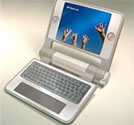Nicholas Negroponte designs a sub-$100 laptop
By By Our Infotech Bureau | 30 Sep 2005
 A
laptop that costs less than $100 developed by the Massachusetts
Institute of Technology (MIT) was unveiled recently by
its designer, Nicholas Negroponte. It can work on a hand-cranked
generator where there is no electricity and holds out
promise of bringing IT and the internet to children of
the poorest countries in the world.
A
laptop that costs less than $100 developed by the Massachusetts
Institute of Technology (MIT) was unveiled recently by
its designer, Nicholas Negroponte. It can work on a hand-cranked
generator where there is no electricity and holds out
promise of bringing IT and the internet to children of
the poorest countries in the world.
Nicholas Negroponte, chairman and founder of the Massachusetts Institute of Technology Media Labs, has outlined designs for a sub-$100 PC, reports BBC. The idea of a cheap computer first occurred to Negroponte while visiting a Cambodian village some years ago.
The laptop has been designed to withstand the rigours of developing markets. Tough and foldable in different ways, it even has a hand-crank generator for power where there is no electricity. Power is a big problem in developing nations, which is why the hand crank will be fitted where it is needed.
By using innovative technologies, such as electronic ink displays, the MIT team thinks it can reduce power consumption even further on the computers. Such displays require very little power to work.
 The
Linux-based machine is expected to have a 500MHz processor,
with flash memory instead of a hard drive, as the latter
has more delicate moving parts. It will have four USB
ports, and can connect to the net through wi-fi —
wireless net technology — and will be able to share
data easily.
The
Linux-based machine is expected to have a 500MHz processor,
with flash memory instead of a hard drive, as the latter
has more delicate moving parts. It will have four USB
ports, and can connect to the net through wi-fi —
wireless net technology — and will be able to share
data easily.
Users will be able to switch easily from the colour display to monochrome mode, so that it can be viewed in bright sunlight, at four times normal resolution. The laptops will be encased in rubber to make them more durable, and their AC adaptors will also act as carrying straps.
Negroponte''s non-profit ''One Laptop Per Child'' group wants to produce up to 15 million machines within a year. A prototype is expected to be ready in November, and will be unveiled at the World Summit on the Information Society (WSIS) in Tunisia. Brazil, China, Egypt, Thailand and South Africa will be among the first countries to get the sub-$100 (Rs4,400) computer.
In the US, Massachusetts governor Mitt Romney plans to buy them for all 500,000 middle and high school students in the state, starting next year. Negroponte predicts there could be 100 million to 150 million shipped every year by 2007.
 The
project has some big-name supporters, including Google,
which is working on thin-client applications. Thin client
computing means several machines can share programs when
linked to a central server.
The
project has some big-name supporters, including Google,
which is working on thin-client applications. Thin client
computing means several machines can share programs when
linked to a central server.
Making them so cheap would mean that developing nations would be able to afford to bulk-buy them, though Negroponte admits that even $100 remains too expensive for some. He is committed to the idea that children all over the world should be equipped with technology, so that they can tap into the educational and communications benefits of the net.
There have been several projects to build and distribute cheap computers for developing nations in order to close the digital divide, including the sub-£100 Nivo, developed by the UK not-for-profit group, Ndiyo, and the Indian handheld Simputer.




















